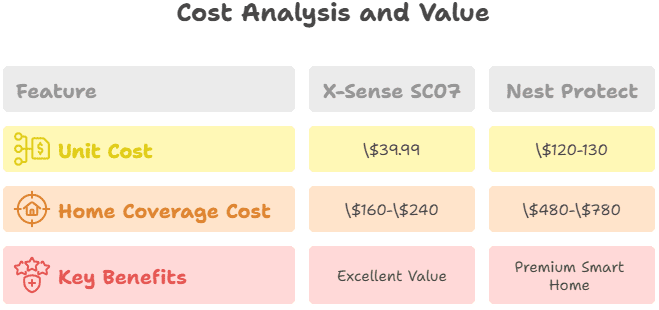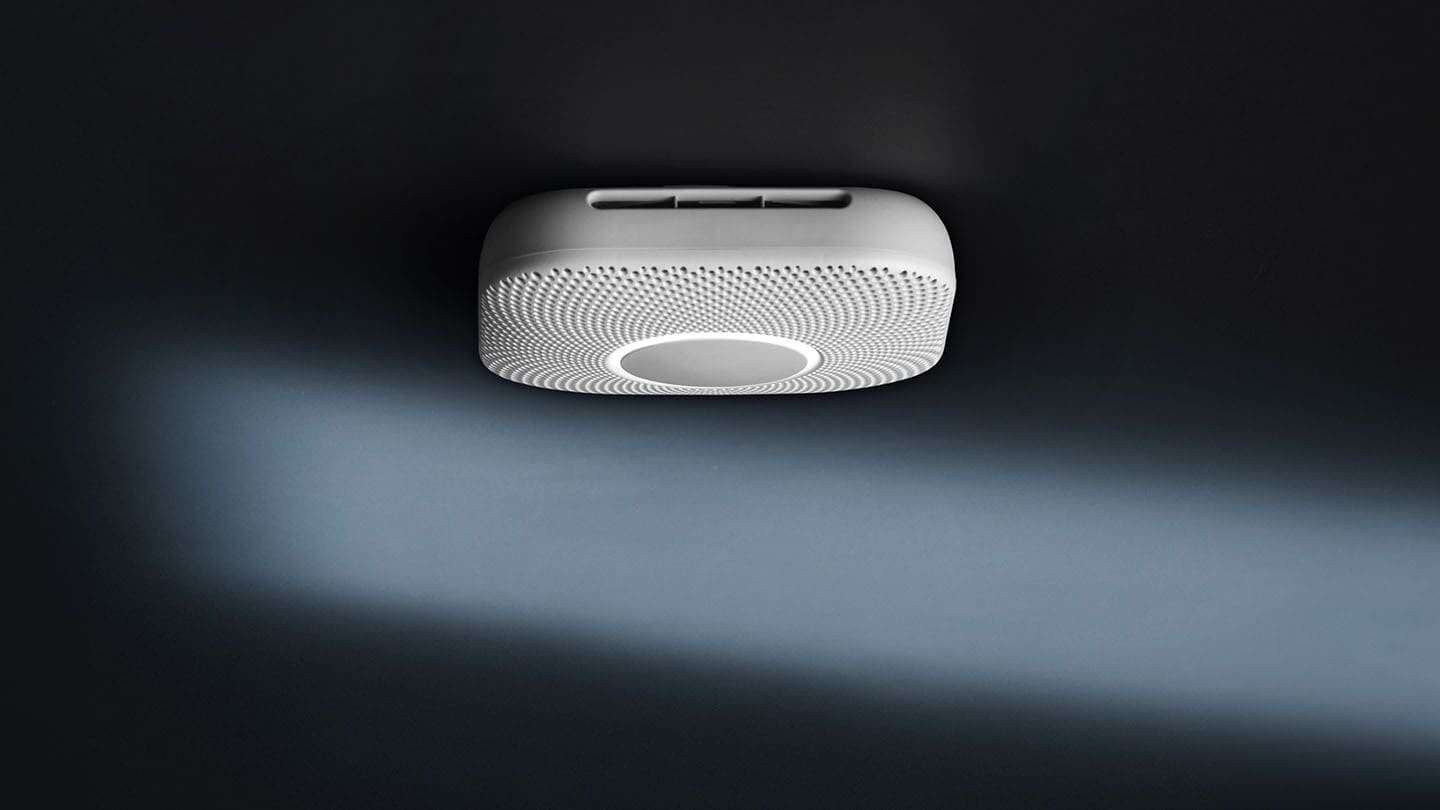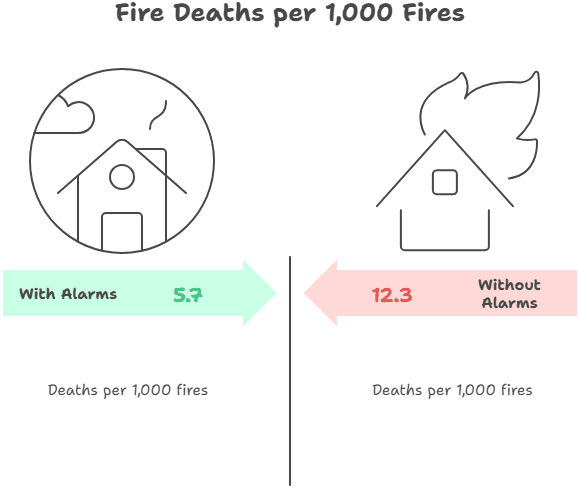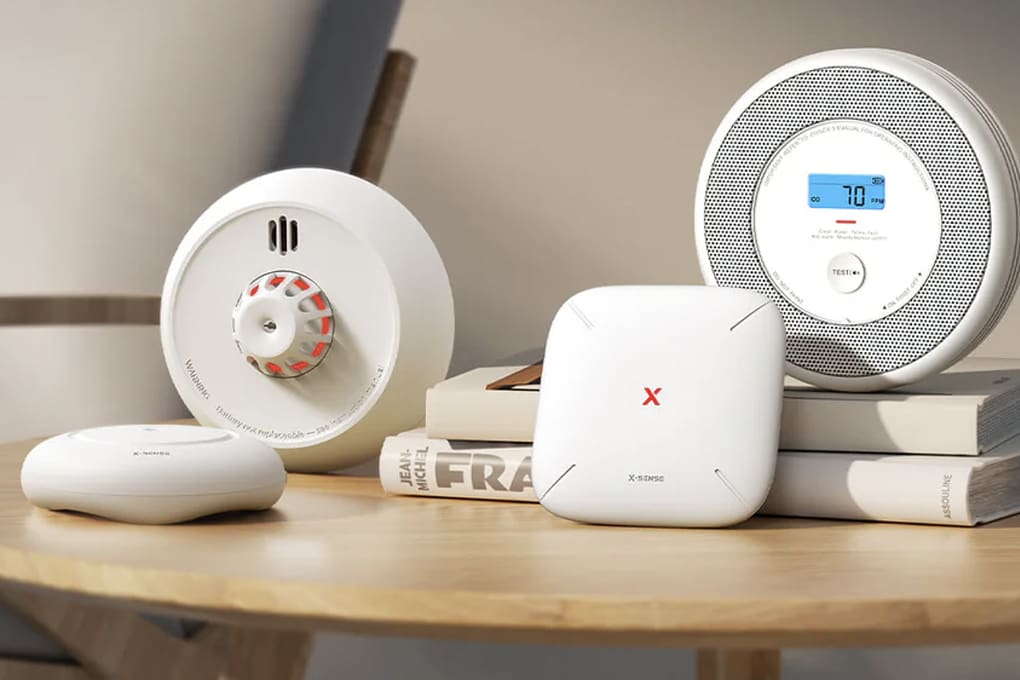Protecting your home and family starts with something as simple as a smoke alarm, yet not all alarms are created equal. Between 2018 and 2022, smoke alarms were present in about three-quarters of reported home fires, but nearly three out of five fire deaths still happened in homes with no alarms or ones that failed to work.
The difference is stark – homes with working alarms see fire death rates that are roughly 60% lower than those without.
Even so, not every alarm is perfect. In homes where smoke alarms did function, almost a third of fatalities occurred when the device didn’t alert occupants, and another 9% happened when people heard the alarm but didn’t respond. That’s why choosing the right device matters.
Today’s smart detectors go beyond traditional beeps. They send instant alerts to your phone, distinguish between different types of smoke, and use clear voice announcements instead of jarring tones.
Between X-Sense and Nest Protect, both offer these modern features but cater to different needs – X-Sense appeals to families who want reliable protection without the premium price tag, while Nest Protect fits homeowners who want full integration with the Google ecosystem.
Let’s find out which of these two smoke detectors keeps you safer.
Table of Contents
- Key Takeaways
- X-Sense vs. Nest Protect Smoke Detectors: Side-by-Side Comparison
- Performance and Detection Accuracy
- Smart Features and App Experience
- Installation and Setup Process
- Battery Life and Maintenance
- Cost Analysis and Value
- Emergency Response and Safety Features
- Integration with Existing Smart Home Systems
- Nest Protect vs. X-Sense: Which Smoke Detector Is Best for Your Home?
- Installation Best Practices and Common Mistakes
- Maintenance Schedules and Long-Term Performance
- Research-Backed Safety Performance
- Building a Complete Home Safety Strategy
- Protect Your Family Today
- Frequently Asked Questions
Key Takeaways
- Between 2018 and 2022, smoke alarms were present in 74% of reported home fires, yet nearly 59% of fire deaths happened in homes with no alarms or non-functioning alarms.
- X-Sense offers reliable detection with dual smoke and CO sensors, a real-time CO ppm display, and a sealed 10-year battery for low-maintenance use.
- Nest Protect uses Split-Spectrum technology, provides voice alerts, app integration, and features like Pathlight and Steam Check to reduce false alarms.
- X-Sense units cost about $39.99 each, making full home coverage affordable, while Nest Protect units cost $120-130 each but add premium smart-home functionality.
- Both detectors support wireless interconnection, though Nest Protect also integrates with Google Home to coordinate lights, media, and thermostats during emergencies.
- Proper installation, monthly testing, and replacement every 10 years are critical for long-term safety and compliance with fire protection standards.
- Visit Batten to find trusted recommendations and products that help you make the best safety choice for your household.
X-Sense vs. Nest Protect Smoke Detectors: Side-by-Side Comparison
| Feature | X-Sense SC07 Smoke & CO Alarm | Nest Protect (2nd Gen) |
| Price (per unit) | $39.99 (1-pack, often discounted in bundles) | $120-130 |
| Sensor Technology | Dual sensors: photoelectric (smoke) + electrochemical (CO) | Split-Spectrum Sensor (dual wavelengths for smoldering + fast-burning fires) + electrochemical CO sensor |
| CO Readout | LCD display shows real-time CO levels (30-999 ppm) | No ppm display; alerts via voice and app notifications |
| False Alarm Reduction | Intelligent chipset reduces false alerts from cooking; LED and LCD provide status clarity | Steam Check prevents false alarms from shower steam or kitchen humidity |
| Alarm Loudness | ≥ 85 dB at 10 ft | 85 dB siren with additional spoken alerts |
| Voice Alerts | No | Yes, specifies type and location of emergency (“Smoke in the kitchen”) |
| Visual Indicators | 3-color LED (red, yellow, green) + LCD readout for CO | Light ring (green = OK, yellow = warning, red = emergency) + Pathlight illumination |
| Smart App Features | X-Sense app: battery status, CO readings history, alarm notifications | Google Home app: hush alarms from phone, push alerts to all family accounts, activity history, maintenance reminders, safety tips |
| Smart Home Integration | Limited to X-Sense interconnection (alarms communicate with each other) | Full Google Home integration: can trigger lights, pause media, adjust thermostats, coordinate with other Nest devices |
| Battery Type | 10-year sealed CR123A lithium (non-replaceable) | 6 AA replaceable batteries (6-7 years lifespan) or hardwired version with backup batteries |
| Battery Replacement | Entire unit replaced after 10 years | Replaceable batteries; unit lasts 10 years before replacement |
| Self-Testing | Self-check every 60 seconds for functionality | Automatic self-test >400 times per day; monthly Sound Check for speaker/siren |
| Maintenance Reminders | Indicator lights + CO readout | App-based reminders; Nightly Promise green glow confirms system working |
| Installation | DIY with included screws, anchors, and bracket; no wiring required | DIY with included mount and app setup; Wi-Fi connection required for smart features |
| Connectivity | Wireless interconnection between X-Sense units (no Wi-Fi required) | Wi-Fi required for full smart features and remote alerts |
| Emergency Features | Loud siren, LED indicators, LCD CO readout, app push alerts | Voice announcements, siren, light ring indicators, Pathlight emergency illumination |
| Special Features | LCD screen with live CO ppm, compact size, affordable multi-unit coverage | Pathlight (motion-activated night light), App Silence, Nightly Promise, family account sharing |
| Operating Temperature | 40-100°F (4.4-37.8°C) | 40-100°F (4.4-37.8°C) |
| Operating Humidity | 10%-85% (non-condensing) | 20%-80% (non-condensing) |
| Product Dimensions | 5.7 × 5.7 × 2.0 in | 5.3 × 5.3 × 1.5 in |
| Weight | 0.66 lb (300 g) | 0.79 lb (360 g) |
| Warranty | 5-year manufacturer warranty | 2-year limited warranty (when sold new) |
| Best For | Budget-conscious families, renters, homeowners wanting reliable detection without smart-home extras | Tech-forward homeowners with Google Home ecosystem who want premium smart integration and advanced detection features |
Performance and Detection Accuracy
Both detectors use dual-sensor technology, but their approaches differ. X-Sense SC07 combines a photoelectric sensor for smoke and an electrochemical sensor for carbon monoxide.
The unit’s intelligent chipset improves response times to smoldering fires while reducing nuisance alarms from everyday cooking. It also includes an LCD that displays real-time CO readings (30-999 ppm), battery status, and alarm condition.
Nest Protect takes detection further with its proprietary Split-Spectrum Sensor, which uses two wavelengths of light to distinguish between fast-burning and slow-smoldering fires. In addition, it includes Steam Check, which uses temperature and humidity data to reduce false alarms from showers or cooking steam.
In real-world use, Nest Protect provides more nuanced differentiation with fewer false alerts, while X-Sense reliably covers core smoke and CO detection at a much lower price point. For families prioritizing essential safety over extras, X-Sense remains highly effective.

Smart Features and App Experience
The X-Sense app provides essential smart functions: checking battery status, viewing CO concentration history, and receiving push notifications when alarms sound. Its interface focuses on safety basics without unnecessary complexity.
Nest Protect, on the other hand, integrates well into the Google Home ecosystem. Through the app, users get Nightly Promise (a green glow confirming everything works), hush functions via phone, detailed activity reports, and maintenance reminders.
The app can also push notifications to every family member’s phone and integrates with Google Assistant for voice control.
For households already invested in Google devices, Nest Protect creates a more seamless smart home environment. X-Sense, while simpler, appeals to users who want reliability without the distraction of extra features.
Installation and Setup Process
X-Sense SC07 includes screws, anchors, and a mounting bracket, with setup typically taking 10-15 minutes. Most models arrive pre-programmed for wireless interconnection with other X-Sense units, making it simple to scale across multiple rooms.
Nest Protect also installs easily, providing clear instructions and mounting hardware. Once powered, it guides users with voice prompts and connects automatically to Wi-Fi through the Google Home app. The polished onboarding reflects Google’s design philosophy, and users can test functionality through the app immediately.
Both brands also offer hardwired models, but neither requires professional installation. This makes them viable for both renters and homeowners.
Battery Life and Maintenance
X-Sense SC07 uses a sealed lithium battery rated for 10 years, powering the entire lifespan of the unit. There are no replacements – when the battery expires, the alarm must be replaced. This eliminates ongoing maintenance and prevents the 2 a.m. low-battery chirps common with older alarms.
Nest Protect operates with six AA batteries that last about six to seven years under normal conditions. The app provides early warnings before batteries expire, and the Nightly Promise feature confirms each night that the alarm is working. Unlike X-Sense, batteries can be replaced without discarding the device.
The choice depends on user preference: X-Sense appeals to those who want “set it and forget it” reliability, while Nest Protect suits homeowners who prefer replaceable components to extend device life.
Cost Analysis and Value
X-Sense SC07 retails around $39.99 per unit, with multi-packs available at discounted rates. Outfitting a three-bedroom home with four to six detectors costs about $160-$240, making it a cost-effective option for whole-home coverage.
Nest Protect units retail between $120-130 each. Equipping the same home would cost $480-780, nearly triple the price of X-Sense. For that premium, Nest Protect provides advanced features like voice announcements, Pathlight illumination, app hush control, and deep Google integration.
Families focused on core safety will find X-Sense excellent value. Those who prioritize premium smart home integration and advanced detection will see Nest Protect as worth the higher investment.

Emergency Response and Safety Features
Both alarms are designed to wake and alert occupants, but their alerts differ in sophistication.
X-Sense SC07 sounds an 85dB alarm with visual LED indicators (red, green, yellow) and simultaneous push notifications via the app. Its LCD shows CO concentration in ppm, helping users gauge severity.
Nest Protect issues spoken voice alerts alongside its siren, specifying the type and location of the hazard, such as “Emergency, smoke in the kitchen.” This guidance reduces confusion during stressful situations. The Pathlight feature provides illumination during emergencies, improving escape safety, especially for households with children or elderly members.
While both provide effective emergency alerts, Nest Protect offers more context and usability in high-stress moments.
Integration with Existing Smart Home Systems
X-Sense operates as a standalone network, allowing interconnected alarms to communicate with each other. It does not integrate with third-party ecosystems, which appeals to families who want reliability without added complexity.
Nest Protect, by contrast, integrates fully with Google Home. It can activate smart lighting during emergencies, pause media, and adjust thermostats to prevent smoke circulation. It also syncs with other Nest products, allowing a truly connected safety ecosystem.
For users building a broader smart home, Nest Protect’s compatibility often justifies the premium price. X-Sense, however, provides straightforward protection for those who do not need automation.
Nest Protect vs. X-Sense: Which Smoke Detector Is Best for Your Home?
X-Sense and Nest Protect both provide reliable fire safety, but they suit different priorities and household needs. Understanding where each excels will help you choose the right fit.
X-Sense: Best for Budget-Friendly Reliability
X-Sense is an excellent choice for families who want dependable protection without paying premium prices. Its 10-year sealed battery design means you never need to worry about replacements, making it ideal for busy households.

The wireless interconnection feature is particularly useful in larger homes, ensuring that an alarm in one area triggers alerts throughout the property.
X-Sense fits homeowners who prioritize cost-effectiveness, long battery life, and straightforward installation without advanced smart-home integrations.
Nest Protect: Best for Tech-Savvy Integration
Nest Protect is designed for homeowners who want smoke detection seamlessly integrated into their connected home systems.
With app-based alerts, voice announcements, and compatibility with Google Assistant, it keeps you informed in real time, even when away from home. Its ability to distinguish between types of smoke and provide early warnings adds another layer of safety.

Nest Protect works best for tech-forward households, frequent travelers, or anyone who already uses Google’s smart-home ecosystem and values advanced features over lower upfront cost.
For comprehensive guidance on creating a complete safety plan, check out our smoke inhalation prevention guide and consider our detailed X-Sense detector review for additional insights.
Installation Best Practices and Common Mistakes
Proper installation determines how well your detectors protect your family. Both X-Sense and Nest Protect work best when placed according to fire safety guidelines, but many homeowners make errors that reduce effectiveness or create false alarms.

Ceiling and Wall Placement
Install detectors on ceilings or high on walls, since smoke rises. Avoid placing units directly above stoves, fireplaces, or in bathrooms where steam may cause false alarms.
Bedroom and Hallway Coverage
For bedrooms and hallways, position detectors outside sleeping areas but close enough to wake occupants. In homes with ceilings higher than 12 feet, wall mounting between 4 and 12 inches below the ceiling often provides better coverage than ceiling installation.
Interconnected Alarms
Both X-Sense and Nest Protect support wireless interconnection. This means if one alarm sounds, all connected units activate throughout the home. Interconnection is particularly valuable in larger houses where a fire in a basement or garage may not wake people upstairs. Always test this feature monthly to confirm every unit communicates correctly.
Temperature Considerations
Temperature also affects performance. Avoid installing detectors near heating vents or in unconditioned spaces like attics and garages where temperatures can fall outside the optimal 40-100°F range. Both devices function best within this window, and performance may degrade if exposed to extreme conditions.
Maintenance Schedules and Long-Term Performance
Smart detectors reduce maintenance hassles, but consistent care is still essential for reliable performance. Monthly testing, periodic cleaning, and planned replacements keep both X-Sense and Nest Protect functioning effectively.
Monthly Testing
X-Sense uses a physical test button that activates all interconnected units, while Nest Protect allows voice-activated testing through Google Assistant or app-based control. Performing these tests every month ensures alarms will sound when needed.
Preventing Dust Buildup
Dust accumulation is a leading cause of false alarms. To prevent this, clean sensors every six months with compressed air or a soft brush. This simple step keeps detectors accurate and reduces nuisance alerts.
Replacement Timelines
X-Sense units include sealed 10-year batteries, meaning the entire unit must be replaced after a decade. Nest Protect requires AA battery changes every few years, depending on usage, and should also be fully replaced after 10 years due to natural sensor degradation. Tracking these schedules helps prevent sudden failures.
App Monitoring and Notifications
Both X-Sense and Nest Protect provide app notifications for maintenance and system updates. These include battery level indicators, test history, and reminders for upcoming maintenance. Regularly checking the app helps identify issues early and prevents unexpected late-night low-battery chirps.
Research-Backed Safety Performance
When comparing smoke detectors, it is useful to look at data from fire safety research. Studies and industry standards highlight just how critical reliable alarms are for protecting lives.
Life-Saving Impact of Working Alarms
According to the National Fire Protection Association, homes with working smoke alarms cut fire death risk by more than half. The death rate is 12.3 deaths per 1,000 reported home fires in homes without alarms, compared to 5.7 deaths per 1,000 in homes with functioning detectors. These statistics show that installing dependable detectors such as X-Sense or Nest Protect is far more important than which brand you choose.

Evidence From International Studies
A 2016 meta-analysis published in the Fire Safety Journal confirmed this impact on a global scale. Researchers reviewed multiple studies and found households with operational smoke alarms had death rates that were half those of homes without alarms. Because this study included data from different countries, the results apply broadly to the environments where both X-Sense and Nest Protect are used.
Growth of Smart Smoke Detectors
Smart smoke detectors are becoming more common as homeowners value connected safety features. Market research valued the global smart smoke detector market at $2.26 billion in 2023 and projected growth to $4.03 billion by 2030, with an annual growth rate of 8.6%. This growth reflects rising demand for features such as smartphone alerts and remote monitoring.

Technology Standards and Regulation
Industry standards have also improved. As of June 30, 2024, the UL 217 8th Edition standard requires alarms to detect a wider range of fires while reducing false alarms caused by cooking. Both X-Sense and Nest Protect now manufacture units that meet this higher standard, ensuring better real-world reliability.
Addressing the Causes of Detector Failure
Despite technology improvements, maintenance failures remain the leading cause of detector malfunction during emergencies. NFPA data shows that in 43% of cases where alarms failed, missing or disconnected batteries were to blame. This highlights the strength of X-Sense’s 10-year sealed battery design and Nest Protect’s proactive battery monitoring. Both solutions reduce the risk of battery-related failure and improve long-term dependability.
Building a Complete Home Safety Strategy

Smoke and carbon monoxide detectors play a central role in protecting households, but they work best when integrated into a broader safety plan. A well-rounded strategy includes escape planning, remote monitoring, and preparations for emergencies beyond fire incidents.
Fire Escape Planning
Detection is only the first step in fire safety. Every household should maintain a clear escape plan, especially in multi-story homes. Fire escape ladders provide a reliable secondary exit when stairs are blocked. The National Fire Protection Association recommends practicing fire drills at least twice a year so every family member knows how to exit quickly and safely.
Remote Monitoring for Elderly Family Members
For families with elderly parents or relatives living independently, smart detectors with smartphone alerts add another layer of protection.
These devices notify caregivers instantly if smoke or carbon monoxide is detected, allowing rapid response even when family members are not present. Many systems also integrate with broader medical alert and home security platforms, which further increases safety for seniors.
Integrating Fire Detection with Security Systems
A complete home safety strategy often involves connecting smoke detectors with other security features. For example, some systems automatically notify emergency services or trigger home automation functions such as unlocking smart locks or shutting down HVAC systems to slow smoke spread.
When evaluating options, homeowners should consider budget, scalability, and compatibility with existing smart home devices. Our complete guide to buying home security systems covers the essential factors that influence system selection, from budget considerations to feature priorities.
Preparing for Other Emergencies
Fires are only one threat households may face. Power outages, severe weather, and natural disasters also demand preparation. A reliable plan includes having flashlights and backup power sources readily available, storing emergency supplies, and maintaining communication protocols. Families should decide in advance how they will stay in contact if traditional communication networks are disrupted.
Protect Your Family Today
Choosing between X-Sense and Nest Protect comes down to household priorities, but both detectors provide reliable, research-backed protection that significantly lowers fire-related risks. X-Sense offers cost-effective coverage, a sealed 10-year battery, and dependable dual-sensor detection, making it ideal for families who want reliable safety without smart-home complexity.
Nest Protect, on the other hand, provides advanced features such as voice alerts, app-based controls, and Google Home integration, appealing to homeowners who want connected functionality and detailed emergency guidance.
Both systems now meet the updated UL 217 standard, ensuring improved fire detection with fewer nuisance alarms.
When combined with proper installation, regular maintenance, and broader home safety planning, either detector becomes a powerful tool for protecting your family. The most important decision is not which model you select, but that you install dependable alarms and maintain them properly.
Ready to upgrade your home’s fire and carbon monoxide protection? Browse Batten’s curated selection of home safety products to find the right detection system for your family’s needs. From budget-friendly smart detectors to premium integrated systems, we’ve tested and selected products that deliver reliable protection you can trust.
Frequently Asked Questions
How Many Smoke Detectors Should Be Installed in a Home?
The NFPA recommends installing smoke detectors inside every bedroom, outside each sleeping area, and on every level of the home, including the basement. Larger homes may require additional units to ensure full coverage. Interconnected detectors, such as those offered by X-Sense and Nest Protect, are especially important because they ensure alarms are heard throughout the house during emergencies.
Do Smart Smoke Detectors Work Without Wi-Fi?
Yes, both X-Sense and Nest Protect function as standard smoke and carbon monoxide detectors without Wi-Fi. They will still sound alarms when detecting danger. However, Wi-Fi connectivity is required for smartphone notifications, remote monitoring, and advanced app-based features such as silencing alarms or receiving maintenance reminders.
What Is the UL 217 8th Edition Standard?
The UL 217 8th Edition standard, which took effect in 2024, introduced stricter requirements for smoke alarms. Devices must now detect a wider range of fire types, including smoldering and fast-burning fires, while reducing nuisance alarms from cooking. Both X-Sense and Nest Protect meet this updated standard, meaning they provide more reliable real-world performance than earlier models.
How Do Sealed Batteries Compare to Replaceable Batteries?
Sealed lithium batteries, such as those in X-Sense, last 10 years and eliminate the need for replacements. When the battery expires, the entire unit is replaced. Replaceable batteries, such as the AA cells in Nest Protect, typically last 6-7 years and can be swapped out to extend the device’s life until sensors degrade. The choice depends on whether you prefer a set-and-forget system or ongoing maintenance flexibility.
Can Smoke Detectors Be Installed in Garages or Attics?
It is not recommended to install smoke detectors in unconditioned spaces like garages or attics, as extreme temperatures and dust can interfere with performance. Both X-Sense and Nest Protect are rated for 40-100°F with moderate humidity ranges. For these areas, heat detectors or specialized devices designed for harsher environments are a better option.
How Often Should Smoke Detectors Be Replaced?
Both X-Sense and Nest Protect should be replaced every 10 years, regardless of battery status. Over time, smoke and carbon monoxide sensors lose sensitivity, which reduces accuracy. Keeping track of installation dates and replacing units on schedule is one of the simplest ways to ensure dependable protection for your family.
Sources
- Smoke Alarms in US Home Fires report | NFPA
- Smoke alarms: Where to put them, how often to replace batteries
- Proper Placement for Smoke/Heat Alarms, CO Alarms and Fire Extinguishers
- How Often to Check Your Smoke Detector | AHS
- Smoke Alarm Statistics – MySmokeAlarm
- The association between smoke alarm presence and injury and death rates: A systematic review and meta-analysis – ScienceDirect
- Smart Smoke Detector Market | Size, Share, Growth | 2023 – 2030
- New Smoke Alarms Are Better at Detecting Fires but Still Beep for Bacon | NIST




